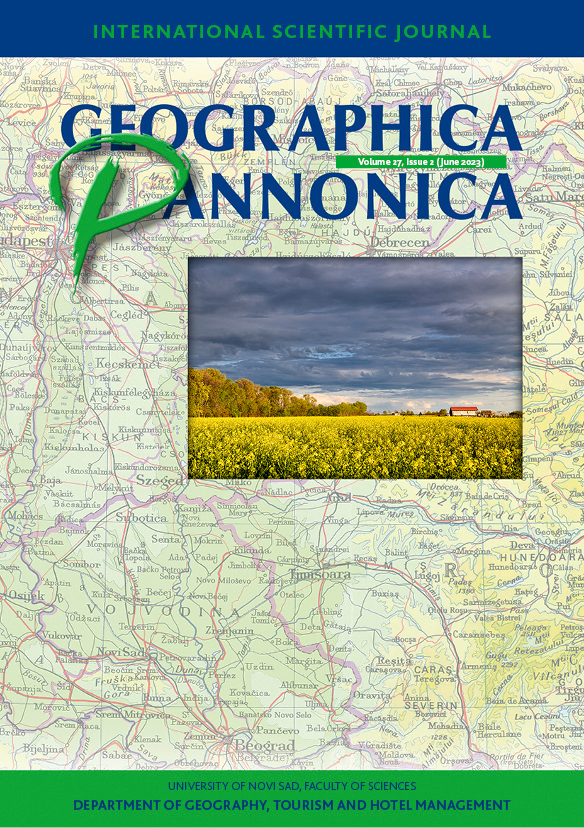Climatic regionalization of Montenegro by applying different methods of cluster analysis
Abstract
To carry out an "objective" regionalization of the climate of Montenegro for the period 1961–2020, this paper used cluster analysis, which is a multivariate technique that classifies a sample of subjects (objects) based on a set of variables into a single number. Based on the results (score), several groups were separated, and similar classes (groups) were grouped into the same cluster. Annual data for mean temperature and total precipitation from 18 meteorological stations were utilized. Temperature and precipitation cluster regions were separated using three different hierarchical agglomerative methods (Unweighted Pair Group Method with Arithmetic Mean (UPGMA), Single linkage, and Ward's) and one non–hierarchical method (K–means). The Euclidean distance was used as a measure of distance for hierarchical methods, and the results were represented graphically in the form of dendrograms and thematic maps. The obtained results indicate that the singled–out temperature and precipitation cluster regions largely coincide with the established climate types in Montenegro. The cluster results further showed that the distribution of meteorological stations clearly reflects the largest part of the climatic diversity of Montenegro and indicates the spatial dimension of temperature and precipitation.
References
. (2011). Cluster–based method for understanding the climactic diversity of Iran. African Journal of Agricultural Research, 6(31), 6525–6529. https://doi.org/10.5897/AJAR11.1321
Aurenhammer, F., & Klein, R. (2000). Voronoi Diagrams. Ch. 5. In J.R. Sack & J. Urrutia (Eds.), Handbook of Computational Geometry (pp.201–290 pp). Amsterdam: Elsevier. https://www.researchgate.net/publication/279959776>
Barber, C. B., Dobkin, D. P., & Huhdanpaa, H. (1996). The quickhull algorithm for convex hulls. ACM Transactions on Mathematical Software (TOMS), 22(4), 469-483. https://doi.org/10.1145/235815.235821
Bensmail, H., Celeux, G., Raftery, A., & Robert, C. (1999). Inference in Model–Based Cluster Analysis. Statistics and Computing, 7(1), 1–10. https://www.researchgate.net/publication/2844935>
Blaney, H.P., & Cridle, W.D. (1950). Determining water requirement in Irrigated areas climatological and Irrigation Data. Washington, USA: USDA Soil Conservation Service. https://ia800300.us.archive.org/4/items/determiningwater96blan/determiningwater96blan.pdf>
Burić D., Ducić V., & Mihajlović, J. (2013). The climate of Montenegro: Modificators and types – part one. Bulletin of the Serbian Geographical Society, 93(4), 83–102. https://doi.org/10.2298/GSGD1304083B>
Burić D., Ducić V., & Mihajlović, J. (2014). The climate of Montenegro: Modificators and types – part two. Bulletin of the Serbian Geographical Society, 94(1),73–90. https://doi.org/10.2298/GSGD1401073B
Burić D., & Doderović M. (2022). Trend of Percentile Climate Indices in Montenegro in the Period 1961–2020. Sustainability, 14(19), 12519. https://doi.org/10.3390/su141912519
Clark, P. J., & Evans, F. C. (1954). Distance to nearest neighbor as a measure of spatial relationships in populations. Ecology, 35, 445–453. https://doi.org/10.2307/1931034>
Davis, J. C. (2002). Statistics and Data Analysis in Geology, 3rd Edition. New York: John Wiley & Sons, pp. 656. https://www.bookdepository.com/Statistics lang="SR-LATN-RS" style="color: blue; mso-ansi-language: SR-LATN-RS;">–Data-Analysis-Geology-John-C-Davis/9780471172758
DeGaetano, A. T., & Shulman, M. D. (1990). A climatic classification of plant hardiness in the UnitedStates and Canada. Agricultural and Forest Meteorology, 51(3–4), 333–351. https://doi.org/10.1016/0168-1923(90)90117-O" target="_blank" rel="noopener">https://doi.org/10.1016/0168-1923(90)90117-O>
Everitt, B.S., Landau, S., & Leese, M., Stahl, D. (2011). Cluster Analysis, Fifth edition. UK: John Wiley & Sons. https://cicerocq.files.wordpress.com/2019/05/cluster-analysis_5ed_everitt.pdf>
Fovell, R. G., & Fovell, M. Y. C. (1993). Climate zones of the conterminous United States defined using cluster analysis. Journal of Climate, 6(11), 2103–2135. https://www.jstor.org/stable/26198599>
Fraley, C., & Raftery, A. (1998). How Many Clusters? Which clustering method? Answers via Model–Based Cluster Analysis. The Computer Journal, 41(8), 578–588.
http://dx.doi.org/10.1093/comjnl/41.8.578
Guibas, L., & Stolfi, J. (1985). Primitives for the manipulation of general subdivisions and the computation of Voronoi. ACM transactions on graphics (TOG), 4(2), 74-123. https://doi.org/10.1145/282918.282923>
Hartigan, J. A., & Wong, M. A. (1979). Algorithm AS 136: A K–Means Clustering Algorithm. Journal of the Royal Statistical Society. Series C (Applied Statistics), 28(1), 100–108. https://doi.org/10.2307/2346830>
Johnson, D. E. (1998). Applied multivariate methods for data analysts, edit 2, New York: Duxbury Press. ISBN–10: 0534237967; ISBN–13: 978–0534237967.
Moreira, E. E., Paulo, A. A., Pereira, L. S., & Mexia, J. T. (2006). Analysis of SPI drought class transitions using loglinear models. Journal of Hydrology, 331(1–2), 349–359. https://doi.org/10.1016/j.jhydrol.2006.05.022" target="_blank" rel="noopener">https://doi.org/10.1016/j.jhydrol.2006.05.022>
MacQueen, J. B. (1967). Some methods for classification and analysis of multivariate observations. In L. M. Le Cam & J. Neyman (Eds.), Proceedings of the fifth Berkeley symposium on mathematical statistics and probability (pp. 281–297). California: University of California Press. https://digitalassets.lib.berkeley.edu/math/ucb/text/math_s5_v1_article-17.pdf>
Nassiri, M., Koocheki, A., Kamali, G. A., & Shahandeh, H. (2006). Potential impact of climate change on rainfed wheat production in Iran: (Potentieller Einfluss des Klimawandels auf die Weizenproduktion unter Rainfed-Bedingungen im Iran). Archives of agronomy and soil science, 52(1), 113-124. https://www.researchgate.net/publication/233020291>
Okabe, A., Boots, B., & Sugihara, K. (2000). Spatial Tessellations: Concepts and Applications of Voronoi Diagrams, 2nd ed. New York: Wiley. ISBN: 978-0-471-98635-5
Papić-Blagojević, N., & Bugar, D. (2009). Osnovne premise analize grupisanja. Škola biznisa: Naučnostručni časopis, 4, 166-173. http://www.vps.ns.ac.rs/SB/2009/4.18.pdf>
Preparata, F. R., & Shamos, M. I. (1985). Computational Geometry: An Introduction. New York: Springer–Verlag, pp. 390. ISBN: 978-1-4612-1098-6
Rencher, A. C. (2002). Methods of Multivariate Analysis, Second edition. Wiley, pp. 715. https://doi.org/10.1002/0471271357>
Szép, I. J., Mika, J., & Dunkel, Z. (2005). Palmer drought severity index as soil moisture indicator: physical interpretation, statistical behavior and relation to global climate. Physics and Chemistry of the Earth, 30(1–3), 231–243. https://doi.org/10.1016/j.pce.2004.08.039" target="_blank" rel="noopener">https://doi.org/10.1016/j.pce.2004.08.039>
Szentimrey, T. (2003). Multiple analysis of series for homogenization (MASH); Verification procedure for homogenized time series, in: Fourth seminar for homogenization and qualitycontrol in climatological databases. Budapest, Hungary, WMO–TD No. 1236, WCDMP No. 56, 193–201.
Szentimrey, T., & Bihari. Z. (2007). Mathematical background of the spatial interpolation methods and the software MISH (Meteorological Interpolation based on Surface Homogenized Data Basis), Proceedings of the Conference on Spatial Interpolation in -Climatology and Meteorology (pp. 17-27), Budapest, Hungary.
The Pennsylvania State University (2004). Ward’s method. Available at: https://online.stat.psu.edu/stat505/lesson/14/14.7>
Van Groenewoud, H. (1984). The climatic regions of New Brunswick: A multivariate analysis ofmeteorological data. Canadian Journal of Forest Research, 14(3), 389–394. https://doi.org/10.1139/x84-069
Warrington, A. (1977). Crop phonological stages. Australian Journal of Agricultural Research, 28(1), 11–27. https://doi.org/10.1071/AR9770011>
Wolter, K. (1987). The Southern Oscillation in surface circulation and climate over the tropical Atlantic, Eastern Pacific, and Indian Oceans as captured by cluster analysis. Journal of Applied Meteorology and Climatology, 26(4), 540-558. https://doi.org/10.1175/1520-0450(1987)026<0540:TSOISC>2.0.CO;2

